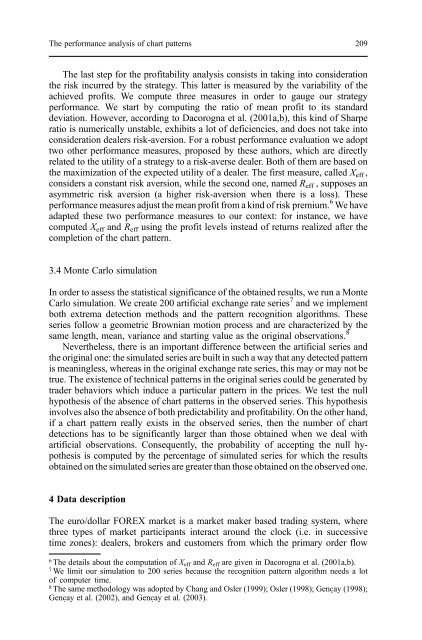recent developments in high frequency financial ... - Index of
recent developments in high frequency financial ... - Index of
recent developments in high frequency financial ... - Index of
You also want an ePaper? Increase the reach of your titles
YUMPU automatically turns print PDFs into web optimized ePapers that Google loves.
The performance analysis <strong>of</strong> chart patterns 209<br />
The last step for the pr<strong>of</strong>itability analysis consists <strong>in</strong> tak<strong>in</strong>g <strong>in</strong>to consideration<br />
the risk <strong>in</strong>curred by the strategy. This latter is measured by the variability <strong>of</strong> the<br />
achieved pr<strong>of</strong>its. We compute three measures <strong>in</strong> order to gauge our strategy<br />
performance. We start by comput<strong>in</strong>g the ratio <strong>of</strong> mean pr<strong>of</strong>it to its standard<br />
deviation. However, accord<strong>in</strong>g to Dacorogna et al. (2001a,b), this k<strong>in</strong>d <strong>of</strong> Sharpe<br />
ratio is numerically unstable, exhibits a lot <strong>of</strong> deficiencies, and does not take <strong>in</strong>to<br />
consideration dealers risk-aversion. For a robust performance evaluation we adopt<br />
two other performance measures, proposed by these authors, which are directly<br />
related to the utility <strong>of</strong> a strategy to a risk-averse dealer. Both <strong>of</strong> them are based on<br />
the maximization <strong>of</strong> the expected utility <strong>of</strong> a dealer. The first measure, called Xeff ,<br />
considers a constant risk aversion, while the second one, named R eff , supposes an<br />
asymmetric risk aversion (a <strong>high</strong>er risk-aversion when there is a loss). These<br />
performance measures adjust the mean pr<strong>of</strong>it from a k<strong>in</strong>d <strong>of</strong> risk premium. 6 We have<br />
adapted these two performance measures to our context: for <strong>in</strong>stance, we have<br />
computed X eff and R eff us<strong>in</strong>g the pr<strong>of</strong>it levels <strong>in</strong>stead <strong>of</strong> returns realized after the<br />
completion <strong>of</strong> the chart pattern.<br />
3.4 Monte Carlo simulation<br />
In order to assess the statistical significance <strong>of</strong> the obta<strong>in</strong>ed results, we run a Monte<br />
Carlo simulation. We create 200 artificial exchange rate series 7 and we implement<br />
both extrema detection methods and the pattern recognition algorithms. These<br />
series follow a geometric Brownian motion process and are characterized by the<br />
same length, mean, variance and start<strong>in</strong>g value as the orig<strong>in</strong>al observations. 8<br />
Nevertheless, there is an important difference between the artificial series and<br />
the orig<strong>in</strong>al one: the simulated series are built <strong>in</strong> such a way that any detected pattern<br />
is mean<strong>in</strong>gless, whereas <strong>in</strong> the orig<strong>in</strong>al exchange rate series, this may or may not be<br />
true. The existence <strong>of</strong> technical patterns <strong>in</strong> the orig<strong>in</strong>al series could be generated by<br />
trader behaviors which <strong>in</strong>duce a particular pattern <strong>in</strong> the prices. We test the null<br />
hypothesis <strong>of</strong> the absence <strong>of</strong> chart patterns <strong>in</strong> the observed series. This hypothesis<br />
<strong>in</strong>volves also the absence <strong>of</strong> both predictability and pr<strong>of</strong>itability. On the other hand,<br />
if a chart pattern really exists <strong>in</strong> the observed series, then the number <strong>of</strong> chart<br />
detections has to be significantly larger than those obta<strong>in</strong>ed when we deal with<br />
artificial observations. Consequently, the probability <strong>of</strong> accept<strong>in</strong>g the null hypothesis<br />
is computed by the percentage <strong>of</strong> simulated series for which the results<br />
obta<strong>in</strong>ed on the simulated series are greater than those obta<strong>in</strong>ed on the observed one.<br />
4 Data description<br />
The euro/dollar FOREX market is a market maker based trad<strong>in</strong>g system, where<br />
three types <strong>of</strong> market participants <strong>in</strong>teract around the clock (i.e. <strong>in</strong> successive<br />
time zones): dealers, brokers and customers from which the primary order flow<br />
6 The details about the computation <strong>of</strong> Xeff and Reff are given <strong>in</strong> Dacorogna et al. (2001a,b).<br />
7 We limit our simulation to 200 series because the recognition pattern algorithm needs a lot<br />
<strong>of</strong> computer time.<br />
8 The same methodology was adopted by Chang and Osler (1999); Osler (1998); Gençay (1998);<br />
Gençay et al. (2002), and Gençay et al. (2003).










